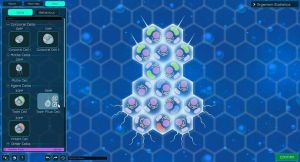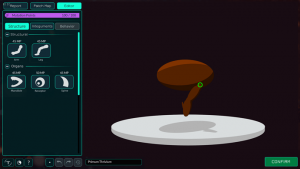Multicellular Stage GDD
Categroy:Only_Online Previous stage: Microbe Stage. Next stage: Aware Stage
The multicellular stage is the second stage of the game. Having recently acquired binding agents, and the ability to freely transfer resources between connected cells. The player now possesses the ability to shape a permanent colony of cells, the first true multicellular organism. You start the Multicellular Stage within the editor or by loading one of a collection of predefined saves when starting a new game in the multicellular stage. Either way a single cell of your species resides until you attach copies of your cell, creating your first fixed body plan for your creature. Similar to the previous stage, the multicellular stage is divided between two phases; early multicellular and late multicellular.
There is a dedicated page about the Multicellular Stage in general.
Overview
Much like the prior stage, the Multicellular stage possesses two types of gameplay: Environmental gameplay which consists of the player's organism exploring and surviving it's environment, and editor gameplay which involves the player modifying and adapting their species to better survive while studying changes in the world.
Much like the Microbe Stage, environmental gameplay is based on:
- Exploration
- Resource Gathering
- Interaction with other organisms
- Interaction with the environment
Editor gameplay is based on:
- Seeing the conditions of surrounding patches
- Learning about environmental changes
- Strategic construction of your organism's body plan
- Careful specialization and adaptation of individual cell variants
- Auto-evo
Transitions
The transition from the previous stage is performed by evolving while being part of a cellular colony of appropriate size. This takes the player straight from microbial gameplay to the early multicellular editor. In order to reach the next stage, the player must master cell specialization and tissue development, and effectively create a brain for their organism to become aware.
The early mutilcellular stage transitions into the late when the player possesses an appropriate number of cells in their organism's body plan. Once the requirements are met cells are replaced with tissue, and the player's early body-plan becomes the metaball torso section of their late stage organism. This transition to a macroscopic creature also stops cells from being visible, meaning that this is a major environment change as the player can no longer interact with cells, instead only being able to interact with other macroscopic species made from metaballs in a 3D environment.
Environment
WIP
Biomes
WIP
Resources
WIP
Movement
Movement will be similar to the microbe stage, with your organism facing towards the cursor, and using the WASD keys to move your organism in the accompanying directions relative to the mouse position. This scheme will be used for the early multicellular stage. In the later multicellular stage (with full 3D movement and environment), new additions to the controls are the ability to ascend/jump or descend/crouch using the space key and either Ctrl or C. As well as to pan the camera by turning your organism's head using right click or some other designated button. A possible / likely alternative is to use mouse controls like most 3D games to control the look direction of the player's creature.
An alternative proposal is to use the W and S keys to accelerate or back away from the cursor position, and use the A and D keys to adjust rotation.
Evolution
Evolving in the multicellular stage is much like the previous stage, with reproduction taking the player to the editor where they can evolve their organism. Unlike the cell stage however, the multicellular stage possesses two distinct editors based on the early and late phases.
The early multicellular editor takes place on a hex-grid much like the microbe editor. Instead of parts, hexes will represent entire cells that the player places on their organism to shape it. Each cell can be edited to create new cell types, or simply adapt the old. This is the body plan editor.
The key features are as follows:
- The editing field is a hex-grid with a top-down perspective identical to the microbe editor.
- Instead of placing pre-designed parts, players will place entire cells they have designed.
- Parts list is occupied by cells which the player can modify or clone through the microbe editor to create new cell types.
Once the player's organism is complex enough with a certain amount of cells, the player will be taken to the late stage editor. There will be a button either in the editor or in the stage when the player is ready to go to the editor to become a macroscopic organism. This is where the editor moves to a 3D perspective and allows the player to freely sculpt their organism with tissues (via meta-balls) instead of individual cells. The player's previous body-plan will be converted into a 3D shape that serves as the initial torso of their organism. The likely initial approach is to convert each placed cell into a metaball.
The key features are as follows:
- The editing field is now centered around the organism's torso
- Instead of placing individual cells, the player now shapes the torso and limbs with tissue types.
- Picking parts from a list to place with is replaced with picking materials (tissues) to sculpt with.
- Parts list is occupied by tissues which the player can modify or clone through the microbe editor to create new tissue types similarly to the early phase.
- Player can now sculpt and attach limbs and other advanced parts (parts will be made up of tissues designed by the player instead of being premade literal "parts") to their organism.
Mutations
Much like the microbe stage, the multicellular stage will feature a limited currency, MP, that the player can spend to evolve their organism. All mutations, whether it be placing a mitochondrion on a cell or extending the length of a limb, will deduct a percentage of MP from the same pool. The various MP consuming mutations are as follows:
- Modifying cells and tissues.
- Placing/moving/deleting cells or their constituent parts.
- Sculpting the torso section of the player's organism.
- Sculpting joints and creating limbs.
- Editing integumentary parts such as fur or scales or placing clumps of integuments.
Combat
WIP
Health and Death
WIP
NPCS
WIP
Reproduction
WIP
Organism Editor
The organism editor is roughly divided into two parts in the multicellular stage. It first begins as the early multicellular editor on a 2D hex-grid. But as the player progresses in the stage, they will gradually develop more and more cells until they are no longer distinguishable and become tissues. It is at this point that the player progresses to the late multicellular editor. All mutations will cost MP from the same pool, so the player must carefully consider what changes they make to their organism.
Early Multicellular Editor
The early organism editor takes place in a familiar 2D hex-grid where players will place entire cells onto their organism to shape it. Initially, they will only have a single cell to choose from, but by creating new variants through the microbe editor; they will be able to create distinct organs and regions on their body. Each cell will visually remain 1 hex in size at this scale, regardless of how many parts they have.
- Parts consist of entire individual cells.
- Cells remain uniform in size and shape on the multicellular organism.
- External organelles remain visible, but may potentially block placement on occupied sides.
- New cell types can be created and edited using the microbe editor.
- player can freely add/remove/relocate cells in their organism at the price of MP.
Much like the microbe editor, the multicellular editor features three separate tabs in the editor.
Structure Tab
The structure tab is nigh identical to the microbe editor counterpart. However; instead of proteins and organelles, the multicellular structure tab lists all of the organism's different cell types. The player may also access the microbe editor from here by clicking the "edit" or "create new" buttons located on each cell in the list.
Appearance Tab
TODO
Behavior Tab
TODO
Late Multicellular Editor
The late multicellular editor takes place in a new 3D plane, allowing players to shape their organism from any angle. No longer will individual cells be visible, the organism is now sculpted out of entire tissues. The parts list still consists of different cell types, but they will now be placed on the organism as a tissue, or material that the player will use to shape their organism with.
- The torso can be freely sculpted with different tissue types as needed.
- Placable parts can now be sculpted from tissues instead of individual cells and attached to the torso or limbs.
- Tissue types can still be edited or created just like individual cells in the early phase.
- Joints can be placed on any surface of the creature's torso to create sculptable limbs at a large cost of MP.
Structure Tab
TODO
Integuments Tab
TODO
Behavior Tab
TODO
Game Screens
WIP
Simulation Specifics
WIP
Visuals
WIP
GUI
WIP
Models
WIP
Animations
WIP
Audio
WIP

